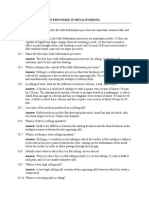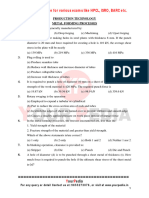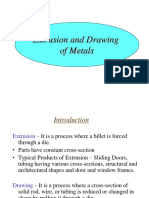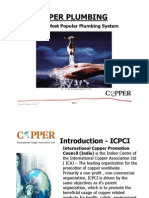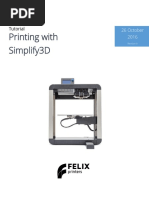Assignment 5 Solution
Uploaded by
v2nxy9jrcyAssignment 5 Solution
Uploaded by
v2nxy9jrcyAssignment 6
A. Answer the following questions with short answer:
1. What are the differences between bulk deformation processes and sheet metal processes?
Answer. In bulk deformation, the shape changes are significant, and the work parts have
a low area-to-volume ratio. In sheet metal processes, the area-to-volume ratio is high.
2. Extrusion is a fundamental shaping process. Describe it.
Answer. Extrusion is a compression process in which the work material is forced to flow
through a die orifice, thereby forcing its cross section to assume the profile of the orifice.
3. Why is the term press working often used for sheet metal processes?
Answer. The term press working is used because most sheet metal operations are
performed on presses.
4. What is the difference between deep drawing and bar drawing?
Answer. Deep drawing is a sheet metal forming process used to fabricate cup-shaped
parts; bar drawing is a bulk deformation process used to reduce the diameter of a
cylindrical work part.
5. List some of the products produced on a rolling mill.
Answer. Rolled products include flat sheet and plate stock, round bar and rod stock, rails,
structural shapes such as I-beams and channels.
6. What is draft in a rolling operation?
Answer. Draft is the difference between the starting thickness and the final thickness as
the workpiece passes between the two opposing rolls.
7. What is sticking in a hot rolling operation?
Answer. Sticking is a condition in hot rolling in which the surface of the workpiece
adheres to the rolls as the piece passes between the rolls, causing severe deformation of
the metal below the surface in order to allow passage through the roll gap.
8. Identify some of the ways in which force in flat rolling can be reduced.
Answer. Ways to reduce force in flat rolling include (1) use hot rolling, (2) reduce draft
in each pass, and (3) use smaller diameter rolls.
9. Distinguish between direct and indirect extrusion.
Answer. In direct extrusion, also known as forward extrusion, a metal billet is loaded
into a container, and a ram compresses the material, forcing it to flow through a die
opening at the opposite end of the container. In indirect extrusion, also known as
backward extrusion, the die is incorporated into the ram, and as the ram compresses into
the metal billet, the metal is forced to flow through the die opening in a direction that is
opposite (backwards) of the ram motion.
10. Name some products that are produced by extrusion.
Answer. Products produced by continuous extrusion include structural shapes (window
Fall 2022 / 2023 Manufacturing Technology
frames, shower stalls, channels), tubes and pipes, and rods of various cross sections.
Products made by discrete extrusion include toothpaste tubes, aluminium beverage cans,
and battery cases.
B. Choose the correct answer(s):
1. Which of the following is typical of the starting work geometry in sheet metal processes:
(a) high volume-to-area ratio or (b) low volume-to-area ratio?
Answer. (b).
2. Hot working of metals refers to which one of the following temperature regions relative
to the melting point of the given metal on an absolute temperature scale: (a) room
temperature, (b) 0.2Tm, (c) 0.4Tm, or (d) 0.6Tm?
Answer. (d).
3. The starting workpiece in steel hot rolling of plate and sheet stock is which of the
following (one best answer): (a) bar stock, (b) billet, (c) bloom, (d) slab, or (e) wire
stock?
Answer. (d).
4. The maximum possible draft in a rolling operation depends on which of the following
parameters (two correct answers): (a) coefficient of friction between roll and work, (b)
roll diameter, (c) roll velocity, (d) stock thickness, (e) strain, and (f) strength coefficient
of the work metal?
Answer. (a) and (b).
5. Which of the following are alternative names for indirect extrusion (two correct answers):
(a) backward extrusion, (b) direct extrusion, (c) forward extrusion, (d) impact extrusion,
and (e) reverse extrusion?
Answer. (a) and (e).
6. The production of tubing is possible in indirect extrusion but not in direct extrusion: (a)
true or (b) false?
Answer. (b). Tube and pipe cross sections can be produced by either direct or indirect extrusion.
7. In which of the following extrusion operation is friction a factor in determining the
extrusion force (one best answer): (a) direct extrusion or (b) indirect extrusion?
Answer. (a).
8. A circular sheet metal slug produced in a hole punching operation will have the same
diameter as which of the following: (a) the die opening or (b) the punch?
Answer. (a).
9. The cutting force in a sheet metal blanking operation depends on which mechanical
property of the metal (one correct answer): (a) compressive strength, (b) modulus of
elasticity, (c) shear strength, (d) strain rate, (e) tensile strength, or (f) yield strength?
Answer. (c).
10. The holding force in drawing is most likely to be (a) greater than, (b) equal to, or (c) less
than the maximum drawing force?
Answer. (c).
AASTMT 1|Page
You might also like
- Assignment3forming Solutions 121213110849 Phpapp02No ratings yetAssignment3forming Solutions 121213110849 Phpapp024 pages
- Review Questions - 2 Group of Review QuestionsNo ratings yetReview Questions - 2 Group of Review Questions3 pages
- CH 19-Def Volumetrica de Solucionario de GroverNo ratings yetCH 19-Def Volumetrica de Solucionario de Grover36 pages
- R19 - Mech - Metal Forming Technology - Sample Questions Bank PDFNo ratings yetR19 - Mech - Metal Forming Technology - Sample Questions Bank PDF7 pages
- Experimental Modal Analysis by Peter AvitabileNo ratings yetExperimental Modal Analysis by Peter Avitabile25 pages
- Actual Questions Asked in BARC Interview Metal FormingNo ratings yetActual Questions Asked in BARC Interview Metal Forming7 pages
- ME6301 MANUFACTURING TECHNOLOGY - 1 - UNIT 3 - 2marksNo ratings yetME6301 MANUFACTURING TECHNOLOGY - 1 - UNIT 3 - 2marks5 pages
- MANISH KUMAR ECEB 69 ASSINGMENT 2 MANUFACTURING PROCESSNo ratings yetMANISH KUMAR ECEB 69 ASSINGMENT 2 MANUFACTURING PROCESS7 pages
- MANISH KUMAR ECEB 69 ASSIGNMENT 2 MANUFACTURING PROCESSNo ratings yetMANISH KUMAR ECEB 69 ASSIGNMENT 2 MANUFACTURING PROCESS7 pages
- Composite Structures of Steel and Concrete: Beams, Slabs, Columns and Frames for BuildingsFrom EverandComposite Structures of Steel and Concrete: Beams, Slabs, Columns and Frames for BuildingsNo ratings yet
- Control of Cracking in Reinforced Concrete Structures: Research Project CEOS.frFrom EverandControl of Cracking in Reinforced Concrete Structures: Research Project CEOS.frNo ratings yet
- Showa Denko Chloroprene Types Selection Guide Version 18 WNo ratings yetShowa Denko Chloroprene Types Selection Guide Version 18 W9 pages
- FaygoPlast - 16 110mm PVC Pipe Production Line 2023-6-5No ratings yetFaygoPlast - 16 110mm PVC Pipe Production Line 2023-6-510 pages
- PE Pipe Production Process & QA-QC Requirements & Standards0% (1)PE Pipe Production Process & QA-QC Requirements & Standards35 pages
- Rubber Sheets Calendering: Contribution To Preventing The Occurrence of Gas EntrapmentsNo ratings yetRubber Sheets Calendering: Contribution To Preventing The Occurrence of Gas Entrapments9 pages
- Voulme 1 Hydraulic Presses Design of Press Body PDFNo ratings yetVoulme 1 Hydraulic Presses Design of Press Body PDF32 pages
- Size Enlargement, Agglomeration: Prof. Dr. J. Tomas, Chair of Mechanical Process EngineeringNo ratings yetSize Enlargement, Agglomeration: Prof. Dr. J. Tomas, Chair of Mechanical Process Engineering31 pages
- Kinematical Analysis On The Several Linkage Drives For Mechanical PressesNo ratings yetKinematical Analysis On The Several Linkage Drives For Mechanical Presses13 pages













